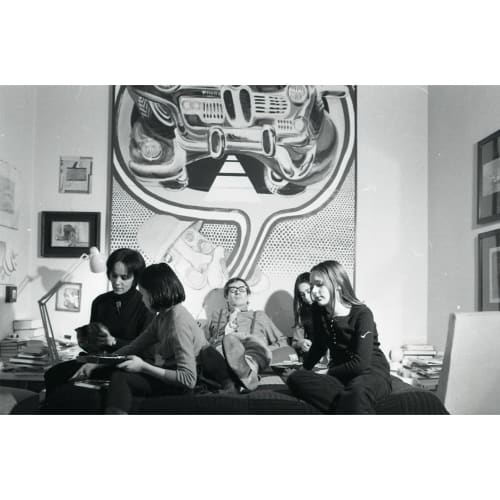Pier Achille (Pirro) Cuniberti was born in Sala Bolognese in 1923 from Zaira Monari and Emilio Cuniberti, a masonite representative (a material that will have a great importance for the future artistic activity of Pirro). His parents encouraged him in the activity of drawing from an early age and at the age of ten he was awarded a prize at the Argonali Nazionali della Cultura e dell'Arte organized by the Opera Nazionale Balilla. In 1939 he enrolled at the Regia Scuola per le Industrie Artistiche in Bologna, where he followed the drawing courses of Ferdinando and Ruggero Rossi who, as Cuniberti declared, "taught me everything I really needed". In 1943 he was called to arms, but after the gloomy years of World War II, Pier Achille continued to learn the arts and in 1948 he graduated from the Academy of Fine Arts where his teachers were Giorgio Morandi and Giovanni Romagnoli. In 1945 he began working as a graphic designer for Ducati, Volkswagen and other brands. In 1948 Cuniberti visited the Venice Biennale and discovered Paul Klee, which will be throughout his career a great point of reference, so as to be defined by the emilian artist a true spiritual father. This was followed by years of great experimentation conducted among drawings, tempera on paper, pastels, small oil paintings and meetings with other characters of the artistic and cultural scene such as Vasco Bendini, Sergio Romiti and Sergio Vacchi.
In this period Cuniberti also began to make his first pen drawings tending towards abstraction, made on machine paper with the new ballpoint pen, which soon became the artist's preferred medium: "the ballpoint pen is an extraordinary medium that allows me to draw thick and thin and allows me to express myself with great lightness...". In 1953 Cuniberti was called to teach Professional Drawing in the Pictorial Decoration section, a position that defined his role as a teacher conducted in parallel with his work as an artist. Drawing represents the leading thread of all his work: through tensions and subtle graphic vibrations, Cuniberti created a unique poetic language within the so-called "fantastic line" of post-war Italian painting, an expression through which he transmits a vision of the world attentive to everyday and topical themes. In 1957 he was introduced by Francesco Arcangeli at the Circolo Culturale in Bologna, where he held his first personal exhibition. The first exhibitions brought the first awards: after participating in 1965 at the IX Quadrenniale in Rome, he was awarded the following year at the XII Premio Spoleto with his painting Tentativo di dialogo con un ufficiale di frontiera. Later he presented other works at the X and XI Quadrenniale in Rome and began collaborating as a graphic designer with Il Resto del Carlino. In 1979 Cuniberti started replacing canvas with masonite boards - a material obtained from pressed wood laminate - prepared with an acrylic base and painted with acrylic colors then diluted with the intervention of pastels and graphite. His first anthology dates back to 1984, set up at the Pinacoteca di Bologna and followed seven years later by another anthology curated by Claudio Cerritelli and Dario Trento. The last few years have been marked by other anthologies and artistic collaborations, such as the one with Giosetta Fioroni with whom in 1992 he created a four-handed drawing for the book Mano Doble. Cuniberti's latest exhibitions are hosted at the Archaeological Museum of Bologna (2003) and at the ESSO Gallery in New York (2008). Some works by Cuniberti are preserved in the Civic Art Gallery of Pieve di Cento, at the Museum of Modern Art in Bologna, at the Civic Gallery of Modena and at the Art Museum of Ravenna. The artist died in Bologna in 2016 and the following year the Galleria d'Arte Maggiore g.a.m. realized an exhibition dedicated to him, curated by Francesco Poli and set up at the Art Warehouse Zattere in Venice, which was on during the 57th edition of La Biennale di Venezia.
